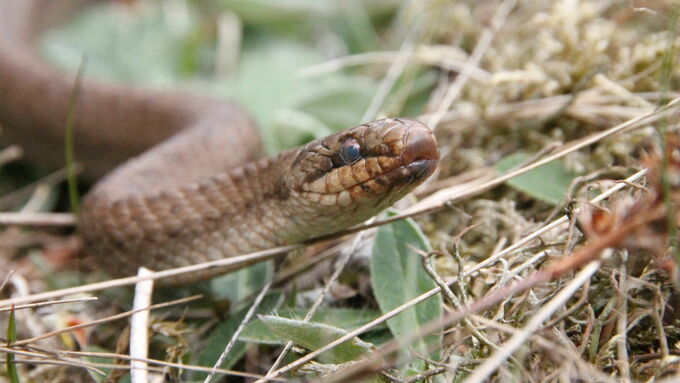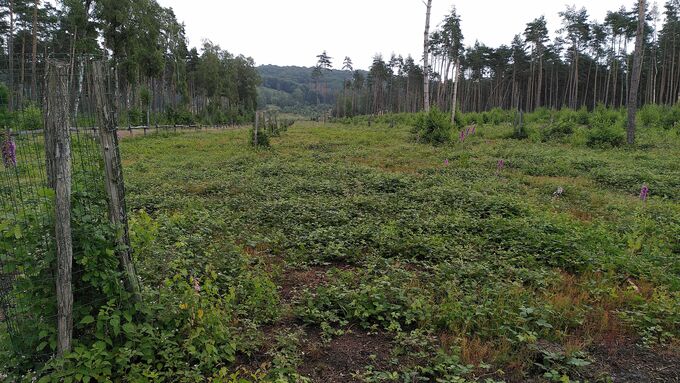Smooth snake in the sand pit ‚Hassler‘ in Oerlinghausen. © Michael Schulte, Biological Station of the district of Paderborn - Senne
download picturemain content
Project of the month
#11/2022 SANDPIT AND NGP SENNE
Conservation and creation of habitat structures for the smooth snake
With its unique mosaic of valuable natural landscape relicts and well-preserved cultural landscape elements, the Senne is one of the most important areas for nature conservation in North Rhine-Westphalia. It is closely interlinked with the large contiguous deciduous forest complex of the Teutoburg Forest and, as a stepping stone in the interregional biotope network, provides suitable habitats for many species. With the help of the nature conservation project ‘Senne und Teutoburger Wald’ (Senne and Teutoburg Forest, NGP), these valuable habitats - heaths, sandy grasslands, extensive grassland and sandy fields - are to be secured and further developed. Since 2003, an area in the surroundings of the Stapel military training area had been funded for this purpose by the federal and state governments. After the end of the funding phase at the end of May 2020, the project became the responsibility of the district of Lippe.
In the ‘Wistinghauser Senne’ in the south of the city of Oerlinghausen, the change from dense coniferous monocultures to sparse mixed deciduous forests has been initiated in the course of the nature conservation project. By grazing Scottish Highland cattle and Exmoor ponies, habitats for many light- and heat-loving plant and animal species have been created in recent years. Within the framework of the LIFE IP Atlantic Region DE, habitat structures for the smooth snake (Coronella austriaca) were preserved or newly created on two areas in this part of the Senne. At the same time, the dispersal of the species was aimed to be promoted by establishing migration corridors.
The first sub-area in the sand pit ‘Hassler’ is a former sand excavation area that currently has a good population of the smooth snake. However, this is isolated due to the current site conditions. In order to maintain the population, measures were necessary to preserve the heath areas and the associated important habitat structures for the species. For this purpose, birch, aspen and blackberry bushes that had grown up on a total area of one hectare were cleared in late summer 2021.
In order to create new habitat structures and dispersal opportunities for the species in the adjacent area, the bull paddock of the NGP, an area of around 0.5 hectares was milled in autumn 2021 to remove the extensive blackberry bushes. The topsoil was removed from another area of around 0.4 hectares. Finally, a transfer of mown material of Scotch heather was carried out to five subareas of different sizes totalling about 2.35 hectares. For this purpose, seed material was obtained from suitable sites in the area of the Senne military training area and the nature reserve ‘Moosheide’ and applied to the areas in Oerlinghausen. The initiated heath development is to be further promoted in the future by grazing with cattle and horses. The sand lizard (Lacerta agilis) and the natterjack toad (Bufo calamita) which occur in the area will also benefit from this action.
The measures were implemented in cooperation with the Lower Nature Conservation Authority of the district of Lippe, the Biological Station of the district Paderborn - Senne and the NGP ‘Senne and Teutoburg Forest’.
Related topics
Further links
- Biological Station of the district of Paderborn – Senne (in German) (external link opens in a new window)
- District of Lippe – Lower Nature Conservation Authority (in German) (external link opens in a new window)
- Naturschutzgroßprojekt „Senne und Teutoburger Wald“ (in German) (external link opens in a new window)





